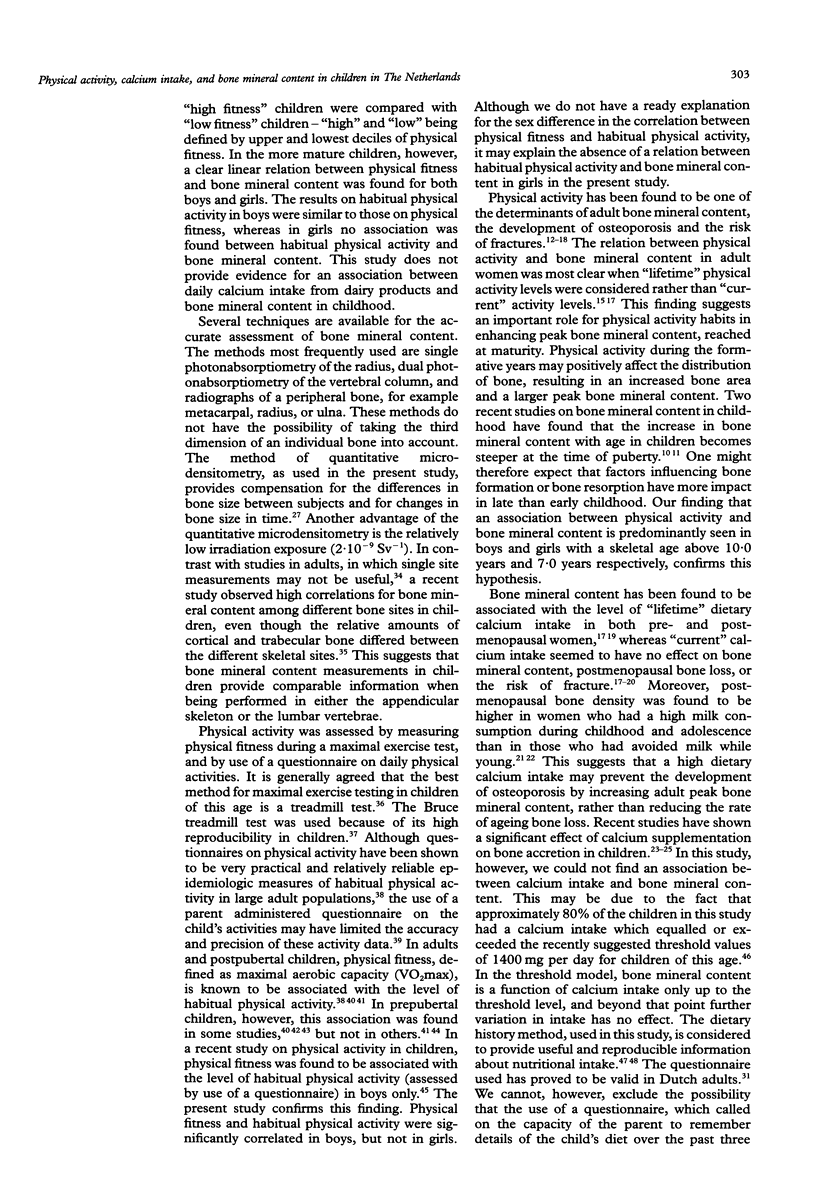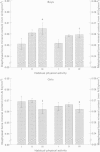Abstract
STUDY OBJECTIVE--To examine the relation between physical activity, calcium intake, and bone mineral content in children. DESIGN--Population based, cross sectional study. SETTING--Primary schools in Zoetermeer, The Netherlands. PARTICIPANTS--Altogether 1359 Dutch boys and girls, aged 7 to 11 years (response rate 88%). MEASUREMENTS--Bone mineral content was measured by quantitative roentgen microdensitometry of the midphalanx of the second digit at the diaphyseal and metaphyseal site. Maximal exercise testing, according to the Bruce treadmill protocol, was used to assess physical fitness. Habitual physical activity was assessed by use of a questionnaire on physical activities. Daily calcium intake from dairy products was estimated by use of a semiquantitative food frequency questionnaire. MAIN RESULTS--Bone mineral content in boys was not linearly associated with physical fitness after adjustments for differences in height, body weight, chronological age, and skeletal age. In girls a linear association was found at the metaphyseal site only. When extreme groups were compared, bone mineral content was found to be higher in "high fitness children" (upper decile) than "low fitness children" (lowest decile), with statistical significance reached in boys only. When analyses were performed in subgroups of skeletal age, a clear linear relation between physical fitness and bone mineral content was seen in the mature subgroup in both boys and girls. No linear association was found between habitual physical activity and bone mineral content, while the results in extreme groups (that is, upper versus lowest decile) and in subgroups of skeletal age were comparable to those on physical fitness in boys only. No association was found between daily calcium intake and bone mineral content in this age group. CONCLUSIONS--This cross sectional study in children aged 7 to 11 years suggests that an increased bone mineral content is found only in those with a high level of physical activity. This association is most pronounced in the more mature children. No evidence was found for an association between daily calcium intake and bone mineral content in childhood.
Full text
PDF





Images in this article
Selected References
These references are in PubMed. This may not be the complete list of references from this article.
- Bruce R. A., Kusumi F., Hosmer D. Maximal oxygen intake and nomographic assessment of functional aerobic impairment in cardiovascular disease. Am Heart J. 1973 Apr;85(4):546–562. doi: 10.1016/0002-8703(73)90502-4. [DOI] [PubMed] [Google Scholar]
- Chow R., Harrison J. E., Notarius C. Effect of two randomised exercise programmes on bone mass of healthy postmenopausal women. Br Med J (Clin Res Ed) 1987 Dec 5;295(6611):1441–1444. doi: 10.1136/bmj.295.6611.1441. [DOI] [PMC free article] [PubMed] [Google Scholar]
- Cooper C., Barker D. J., Wickham C. Physical activity, muscle strength, and calcium intake in fracture of the proximal femur in Britain. BMJ. 1988 Dec 3;297(6661):1443–1446. doi: 10.1136/bmj.297.6661.1443. [DOI] [PMC free article] [PubMed] [Google Scholar]
- Cumming G. R., Everatt D., Hastman L. Bruce treadmill test in children: normal values in a clinic population. Am J Cardiol. 1978 Jan;41(1):69–75. doi: 10.1016/0002-9149(78)90134-0. [DOI] [PubMed] [Google Scholar]
- Dalén N., Olsson K. E. Bone mineral content and physical activity. Acta Orthop Scand. 1974;45(2):170–174. doi: 10.3109/17453677408989136. [DOI] [PubMed] [Google Scholar]
- Ekblom B. Effect of physical training in adolescent boys. J Appl Physiol. 1969 Sep;27(3):350–355. doi: 10.1152/jappl.1969.27.3.350. [DOI] [PubMed] [Google Scholar]
- Eriksson B. O. Physical training, oxygen supply and muscle metabolism in 11-13-year old boys. Acta Physiol Scand Suppl. 1972;384:1–48. [PubMed] [Google Scholar]
- Gilsanz V., Gibbens D. T., Carlson M., Boechat M. I., Cann C. E., Schulz E. E. Peak trabecular vertebral density: a comparison of adolescent and adult females. Calcif Tissue Int. 1988 Oct;43(4):260–262. doi: 10.1007/BF02555144. [DOI] [PubMed] [Google Scholar]
- Gilsanz V., Gibbens D. T., Roe T. F., Carlson M., Senac M. O., Boechat M. I., Huang H. K., Schulz E. E., Libanati C. R., Cann C. C. Vertebral bone density in children: effect of puberty. Radiology. 1988 Mar;166(3):847–850. doi: 10.1148/radiology.166.3.3340782. [DOI] [PubMed] [Google Scholar]
- Glastre C., Braillon P., David L., Cochat P., Meunier P. J., Delmas P. D. Measurement of bone mineral content of the lumbar spine by dual energy x-ray absorptiometry in normal children: correlations with growth parameters. J Clin Endocrinol Metab. 1990 May;70(5):1330–1333. doi: 10.1210/jcem-70-5-1330. [DOI] [PubMed] [Google Scholar]
- Halioua L., Anderson J. J. Lifetime calcium intake and physical activity habits: independent and combined effects on the radial bone of healthy premenopausal Caucasian women. Am J Clin Nutr. 1989 Mar;49(3):534–541. doi: 10.1093/ajcn/49.3.534. [DOI] [PubMed] [Google Scholar]
- Kobayashi K., Kitamura K., Miura M., Sodeyama H., Murase Y., Miyashita M., Matsui H. Aerobic power as related to body growth and training in Japanese boys: a longitudinal study. J Appl Physiol Respir Environ Exerc Physiol. 1978 May;44(5):666–672. doi: 10.1152/jappl.1978.44.5.666. [DOI] [PubMed] [Google Scholar]
- Krabbe S., Christiansen C., Rødbro P., Transbøl I. Effect of puberty on rates of bone growth and mineralisation: with observations in male delayed puberty. Arch Dis Child. 1979 Dec;54(12):950–953. doi: 10.1136/adc.54.12.950. [DOI] [PMC free article] [PubMed] [Google Scholar]
- Kriska A. M., Sandler R. B., Cauley J. A., LaPorte R. E., Hom D. L., Pambianco G. The assessment of historical physical activity and its relation to adult bone parameters. Am J Epidemiol. 1988 May;127(5):1053–1063. doi: 10.1093/oxfordjournals.aje.a114881. [DOI] [PubMed] [Google Scholar]
- Landin L., Nilsson B. E. Forearm bone mineral content in children. Normative data. Acta Paediatr Scand. 1981 Nov;70(6):919–923. doi: 10.1111/j.1651-2227.1981.tb06251.x. [DOI] [PubMed] [Google Scholar]
- Lau E., Donnan S., Barker D. J., Cooper C. Physical activity and calcium intake in fracture of the proximal femur in Hong Kong. BMJ. 1988 Dec 3;297(6661):1441–1443. doi: 10.1136/bmj.297.6661.1441. [DOI] [PMC free article] [PubMed] [Google Scholar]
- Lloyd T., Andon M. B., Rollings N., Martel J. K., Landis J. R., Demers L. M., Eggli D. F., Kieselhorst K., Kulin H. E. Calcium supplementation and bone mineral density in adolescent girls. JAMA. 1993 Aug 18;270(7):841–844. [PubMed] [Google Scholar]
- Matkovic V., Fontana D., Tominac C., Goel P., Chesnut C. H., 3rd Factors that influence peak bone mass formation: a study of calcium balance and the inheritance of bone mass in adolescent females. Am J Clin Nutr. 1990 Nov;52(5):878–888. doi: 10.1093/ajcn/52.5.878. [DOI] [PubMed] [Google Scholar]
- Matkovic V., Heaney R. P. Calcium balance during human growth: evidence for threshold behavior. Am J Clin Nutr. 1992 May;55(5):992–996. doi: 10.1093/ajcn/55.5.992. [DOI] [PubMed] [Google Scholar]
- Matković V., Kostial K., Simonović I., Buzina R., Brodarec A., Nordin B. E. Bone status and fracture rates in two regions of Yugoslavia. Am J Clin Nutr. 1979 Mar;32(3):540–549. doi: 10.1093/ajcn/32.3.540. [DOI] [PubMed] [Google Scholar]
- Mazess R. B., Barden H. S. Interrelationships among bone densitometry sites in normal young women. Bone Miner. 1990 Dec;11(3):347–356. doi: 10.1016/0169-6009(90)90030-j. [DOI] [PubMed] [Google Scholar]
- Mazess R. B. On aging bone loss. Clin Orthop Relat Res. 1982 May;(165):239–252. [PubMed] [Google Scholar]
- Miller J. Z., Slemenda C. W., Meaney F. J., Reister T. K., Hui S., Johnston C. C. The relationship of bone mineral density and anthropometric variables in healthy male and female children. Bone Miner. 1991 Aug;14(2):137–152. doi: 10.1016/0169-6009(91)90091-d. [DOI] [PubMed] [Google Scholar]
- Nilas L., Christiansen C., Rødbro P. Calcium supplementation and postmenopausal bone loss. Br Med J (Clin Res Ed) 1984 Oct 27;289(6452):1103–1106. doi: 10.1136/bmj.289.6452.1103. [DOI] [PMC free article] [PubMed] [Google Scholar]
- Picard D., Ste-Marie L. G., Coutu D., Carrier L., Chartrand R., Lepage R., Fugère P., D'Amour P. Premenopausal bone mineral content relates to height, weight and calcium intake during early adulthood. Bone Miner. 1988 Jul;4(3):299–309. [PubMed] [Google Scholar]
- Pollitzer W. S., Anderson J. J. Ethnic and genetic differences in bone mass: a review with a hereditary vs environmental perspective. Am J Clin Nutr. 1989 Dec;50(6):1244–1259. doi: 10.1093/ajcn/50.6.1244. [DOI] [PubMed] [Google Scholar]
- Riggs B. L., Melton L. J., 3rd Involutional osteoporosis. N Engl J Med. 1986 Jun 26;314(26):1676–1686. doi: 10.1056/NEJM198606263142605. [DOI] [PubMed] [Google Scholar]
- Sandler R. B., Slemenda C. W., LaPorte R. E., Cauley J. A., Schramm M. M., Barresi M. L., Kriska A. M. Postmenopausal bone density and milk consumption in childhood and adolescence. Am J Clin Nutr. 1985 Aug;42(2):270–274. doi: 10.1093/ajcn/42.2.270. [DOI] [PubMed] [Google Scholar]
- Saris W. H. The assessment and evaluation of daily physical activity in children. A review. Acta Paediatr Scand Suppl. 1985;318:37–48. doi: 10.1111/j.1651-2227.1985.tb10081.x. [DOI] [PubMed] [Google Scholar]
- Specker B. L., Brazerol W., Tsang R. C., Levin R., Searcy J., Steichen J. Bone mineral content in children 1 to 6 years of age. Detectable sex differences after 4 years of age. Am J Dis Child. 1987 Mar;141(3):343–344. doi: 10.1001/archpedi.1987.04460030121041. [DOI] [PubMed] [Google Scholar]
- Trouerbach W. T., Hoornstra K., Birkenhager J. C., Zwamborn A. W. Roentgendensitometric study of the phalanx. Diagn Imaging Clin Med. 1985;54(2):64–77. [PubMed] [Google Scholar]
- Trouerbach W. T., de Man S. A., Gommers D., Zwamborn A. W., Grobbee D. E. Determinants of bone mineral content in childhood. Bone Miner. 1991 Apr;13(1):55–67. doi: 10.1016/0169-6009(91)90050-a. [DOI] [PubMed] [Google Scholar]
- Weber G., Kartodihardjo W., Klissouras V. Growth and physical training with reference to heredity. J Appl Physiol. 1976 Feb;40(2):211–215. doi: 10.1152/jappl.1976.40.2.211. [DOI] [PubMed] [Google Scholar]
- Weymans M., Reybrouck T. Habitual level of physical activity and cardiorespiratory endurance capacity in children. Eur J Appl Physiol Occup Physiol. 1989;58(8):803–807. doi: 10.1007/BF02332210. [DOI] [PubMed] [Google Scholar]
- Wickham C. A., Walsh K., Cooper C., Barker D. J., Margetts B. M., Morris J., Bruce S. A. Dietary calcium, physical activity, and risk of hip fracture: a prospective study. BMJ. 1989 Oct 7;299(6704):889–892. doi: 10.1136/bmj.299.6704.889. [DOI] [PMC free article] [PubMed] [Google Scholar]
- Willett W. C., Sampson L., Stampfer M. J., Rosner B., Bain C., Witschi J., Hennekens C. H., Speizer F. E. Reproducibility and validity of a semiquantitative food frequency questionnaire. Am J Epidemiol. 1985 Jul;122(1):51–65. doi: 10.1093/oxfordjournals.aje.a114086. [DOI] [PubMed] [Google Scholar]




